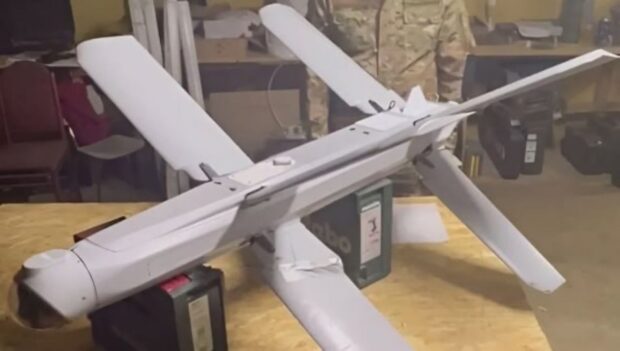Ukrainian soldiers are boasting on social media about their latest achievement – the capture of a Russian unmanned aerial vehicle or an anti-tank kamikaze missile, administered by a particular type of electronic warfare system.
The apprehension of the Lancet drone marks a significant breakthrough for the Ukrainians, as it provides an opportunity to examine its modified structure, which has undergone substantial improvements in recent months. These enhancements encompass the expansion of the warhead from 3 to 5/10 kilos, the extension of the operational range from 40 to over 60 kilometers, and notable enhancements in target precision.
This incident will no doubt serve as an invaluable knowledge resource for Ukrainian technicians, equipping them with insights to enhance their versions of this Russian weapons system. The captured unit, as visible in the image below, appears to be missing a wing.
However, the remaining parts are in excellent condition. This revealing development highlights the improved capacity of Ukrainian Electronic Warfare [EW] systems, whose presence has been increasingly noticeable on the battlefield. This bolstered deployment enables the effective neutralization of various Russian drones, including the diverse versions of the Iranian Shahed/Geran 2 drones.
About Lancet-3
The Zala company, a subsidiary of the Kalashnikov concern, manufactures the Lancet-3. This state-of-the-art Russian NLOS-class UAV is uniquely outfitted with kamikaze/anti-tank guided missile capabilities. It stands out from others due to its specific design—two sets of four fins, arranged in a flattened X form that comprises the control fins and support wings.
The wings—barely different in size between the front and the rear—span one meter, while the body measures 1.6 m in length. In its initial design, the UAV carried a payload of a 3 kg warhead, part of its overall take-off weight of 12 kg. Expectations suggest that this weight might increase up to between 5 and 10 kg, leading to an aircraft structure weight of over 20 kg.
A robust electric motor powers the Lancet-3, allowing for an estimated flight duration of 40 minutes. This UAV can ascend to altitudes of up to 5 km and can maintain horizontal flight speeds of 110 km/h—this rises to 300 km/h during a dive. What sets the Lancet-3 apart is its optoelectronic head, featuring an infrared channel, which enables target detection during various night missions.
Over 800 Lancets were Deployed in the War
As per statistics gathered from February 2022, the onset of the Ukrainian military conflict, until December 29, 2023, Russian forces have launched a staggering 872 Lancet kamikaze drones. This intriguing piece of data was provided by Zala Aero, the manufacturer of these lethal missiles.
Zala Aero released a video showcasing the effectiveness of the Lancet drone in the ongoing conflict with Ukraine. The meticulously produced video, which opens with a chessboard scenario followed by exploding chess pieces, presents the Lancet as a crucial addition to the Russian combat arsenal.
A thought-provoking commentary accompanying the video states: “Official sources have documented 872 instances of Lancet’s involvement in the conflict as of December 29, 2023.” The commentary further reveals that these deadly drones have attained an impressive 80% hit rate. Zala Aero attributes the destruction of 698 Ukrainian targets to this success.
The company firmly maintains that this period has seen significant advancements in the Lancet’s features and functionality, primarily driven by artificial intelligence integration. The video highlights that Ukrainian bases equipped with aviation equipment have consistently been attractive targets.
Flying in Low Visibility
An outstanding feature of the Lancet is its enhanced functionality in extraordinarily low visibility conditions. Ukrainian sources, as cited on BulgarianMilitary.com, revealed modifications to the drone’s structure in a recent update back in November. The most significant of these changes is the inclusion of a new optical module, vastly improving the drone’s operational capabilities, especially during nighttime missions or under low illumination.
Russian sources hint at a phased integration of these Lancet enhancements, indicating varying degrees of technological advancement among the Lancet drones employed across diverse Russian military divisions. The result is the differing access to cutting-edge versions among various units.
A video reel from Zala Aero showcasing the remarkable abilities of the Russian kamikaze drone demonstrates a wide array of equipment it can neutralize. Its hit list over the past two years includes tanks, howitzers, armored infantry vehicles, and Ukrainian landing craft.
Izdelie 53
Interestingly enough, one significant detail left out of the video is the so-called Izdeliye 53, a relatively recent design whose application in the military is still rare and largely unproven. What sets the Izdeliye 53 apart from preceding Lancet models is its spirally arranged wings, marking a distinct departure from the conventional drone body configuration.
Furthermore, the Izdeliye 53 introduces a feature that allows it to release a cluster of drones, with the capacity to deploy up to four drones in a single instance.
This innovative design was thoroughly discussed by BulgarianMilitary.com, which also offered an insider’s peek into the newly established drone manufacturing workspace, intriguingly situated in a repurposed shopping mall in Moscow.
Source: Bulgarian Military






